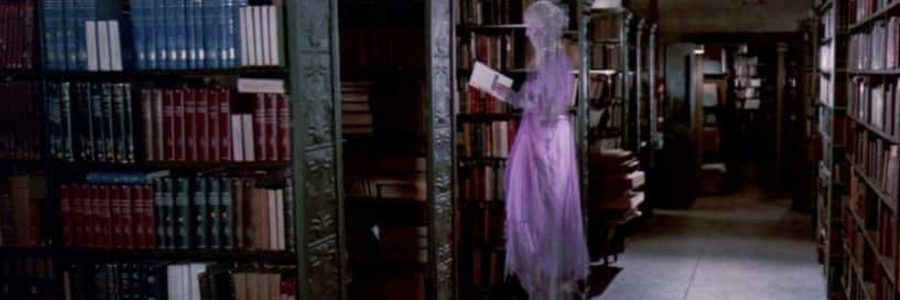
Ghosts in the library: or, a bibliographical mystery solved
Information presented to library users in online catalogues is usually taken to be true and might rarely be questioned. Elements which might be passed over by many (the complex formulae of signatures, which lay out the physical structure of the book, for example), are taken as fact, not least because they are often presented under the aegis of an institution with a formidable reputation for academic excellence. Though it may seem to be devoid of any connection with fallible human thought processes, much of the information presented in an online record has been distilled from detailed and often complicated work done by researchers and bibliographers of the past and – as such – it is always possible for human error to creep in. As a result, those of us working with historic printed collections often need to check details (including pagination, the inclusion and placement of woodcuts or engravings, or the presence of misprints) in order to correctly identify early printed books, and to correct errors made in past generations.
Last week we in the Rare Books Department received an enquiry from the editors of BP16 (Bibliographie des éditions parisiennes du 16e siècle), an online bibliography of books printed in Paris in the sixteenth century based on the research of the French bibliographer Philippe Renouard (1862-1934). The enquiry sent me on the trail of a book by the great German artist Albrecht Dürer – his De symmetria partium humanorum corporum (On the symmetry of the human body) – a work which explored pose and proportion from an artistic point of view. First published in Nuremberg in 1528 (in German as Vier Bücher von menschlicher Proportion), it would later be printed in cities including Paris and Venice. One of the editions listed in BP16 (printed in Paris in 1535), so the enquiry noted, is exceedingly rare, with just two copies known to exist – held at the University Library and in St John’s College Cambridge – as shown in the BP16 entry:
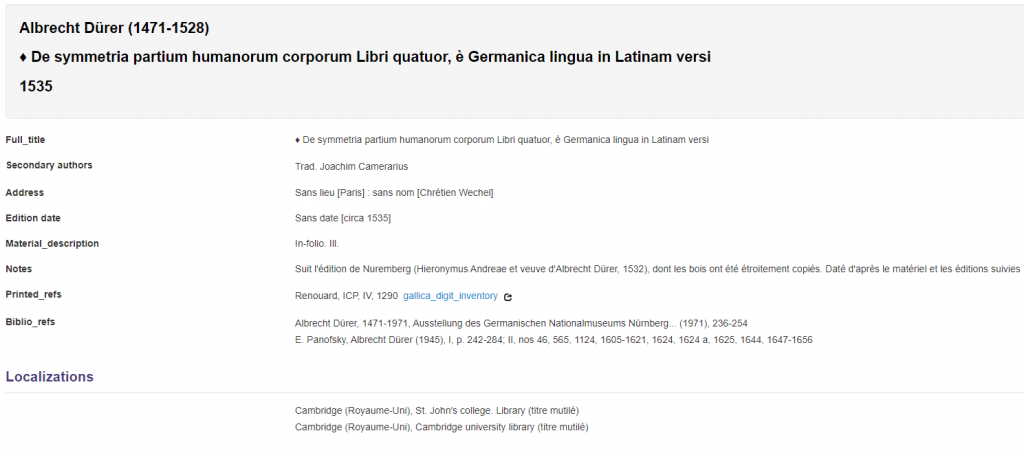
Such a degree of rarity is, perversely, fairly common: we at the University Library look after many books which are the sole surviving copy of an edition which once numbered hundreds. BP16 gives bibliographical information on the book, including its size/format (folio), notes that both CUL and St John’s copies have mutilated title pages, provides references to other bibliographies which cite it, and – crucially – a note that it carries no printer’s name or publishing date but that it is surmised to have come from the press of Chrétien Wechel (1495-1554) in Paris and was printed c. 1535. This information was taken from the Catalogue of books printed on the continent of Europe 1501-1600 in Cambridge libraries (1967) compiled by H. M. Adams (1893-1985), Librarian of Trinity College Cambridge and President of the Bibliographical Society. His entry D-1052 (see below) uses square brackets to surround the place of printing, printer’s name and date, a device used by cataloguers of early printed books to tell users that the information presented is not found within the book itself, but has been inferred from other evidence, further details of which may be specified in the entry. Since the BP16 editor in Paris could not find an edition of 1535 in our online catalogue, they were keen for us to check our copy.
A search in the online catalogue and a trip into the stacks turned up a volume at the shelfmark M.8.22, containing three works by Dürer. The title (below left) has been neatly cut, removing all but the upper five printed lines including – presumably – the printer’s name and date, and allowing the first text page to show through from beneath. This evidence means it is indeed the copy catalogued at D-1052 by Adams. The volume (as shown by the title page of the first item in the volume, below right) was part of the library of Elizabethan collector Thomas Knyvett (1539-1618), and found its way in the late seventeenth century into the library of John Moore, Bishop of Ely. In turn, his collection made its way into the University Library in 1715 when King George I purchased Moore’s vast library of 30,000 books as a gift for Cambridge.
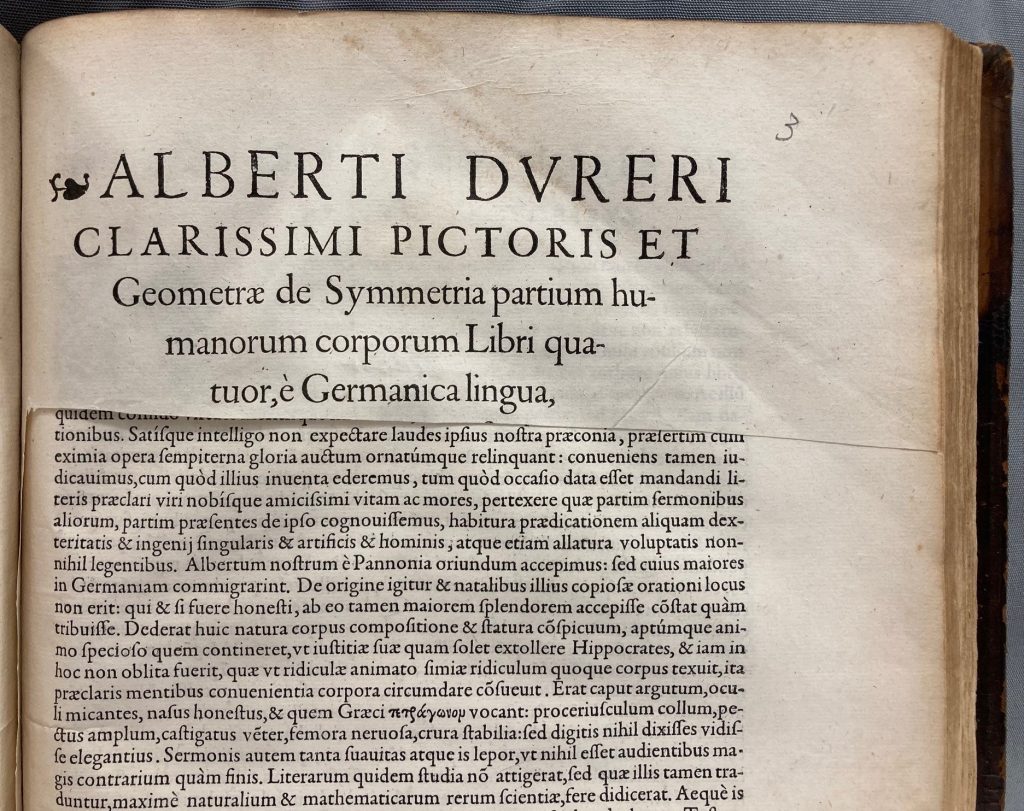
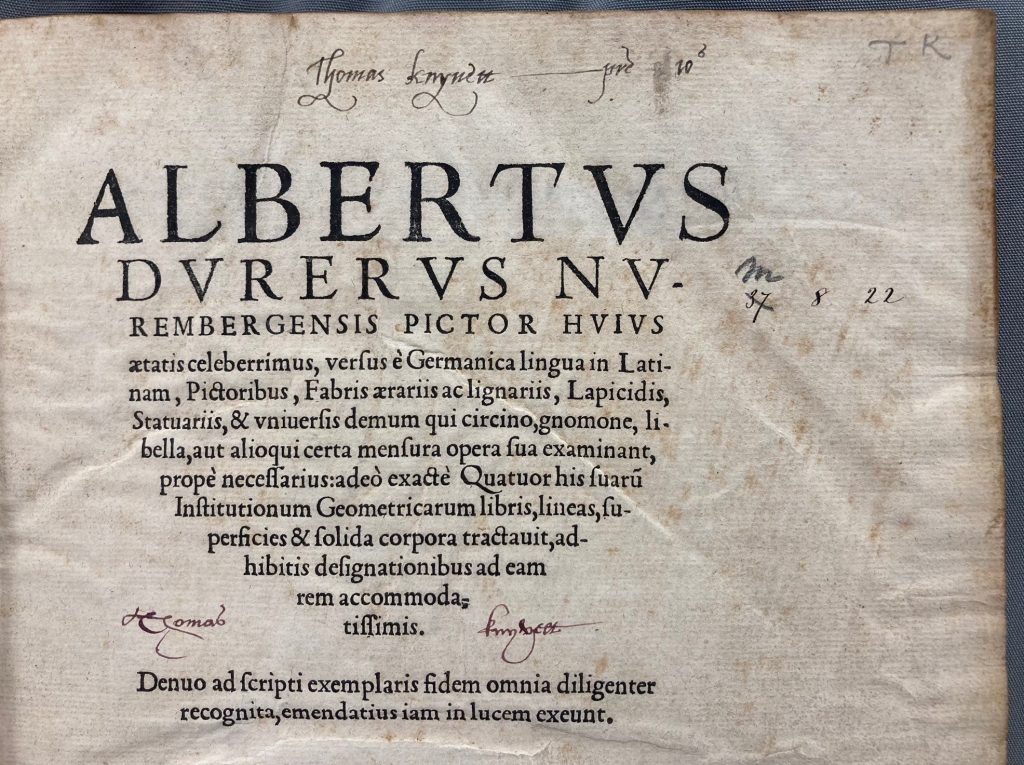
In looking up the work in our online catalogue iDiscover, I was surprised to see two things: (1) that our record dated the book to 1557 (not 1535), and (2) that we had a second copy, which came to us in 1982 with the library of Sir Geoffrey Keynes. Perhaps this rare 1535 edition was not quite as rare as previously thought. This ‘second’ copy had exactly the same makeup of 122 leaves (as given in Adams’s description, above) as the copy at M.8.22, and its title page (below left) was identical to the remaining upper five lines of the title page in M.8.22. It would seem, therefore, that our copy – listed by Adams as [Paris, 1535] and shelved at M.8.22 – was not as early as he believed, but was in fact a copy of a later (Paris, 1557) edition, of which several copies are held in Cambridge college collections.
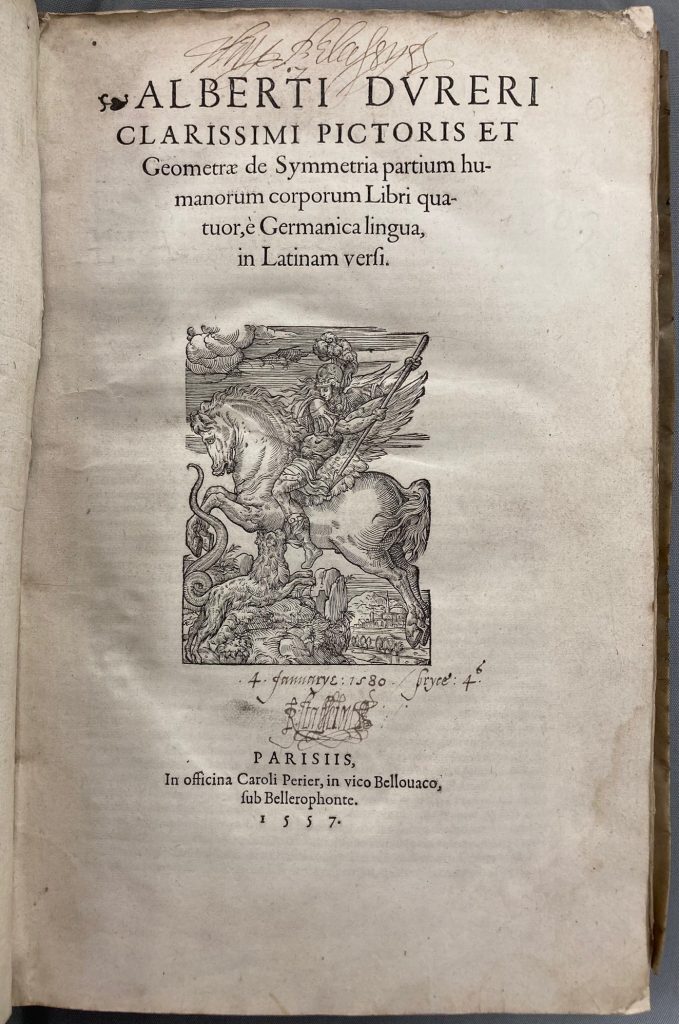
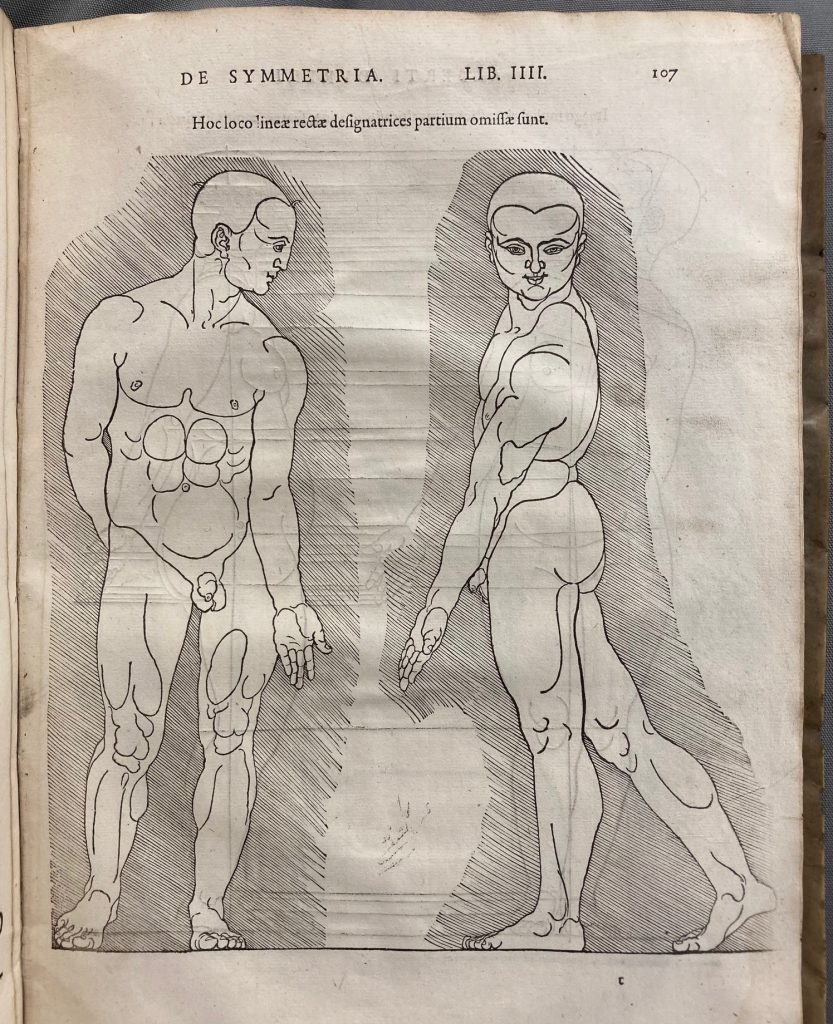
In looking at copies of the sixteenth-century editions, and comparing various nineteenth- and twentieth-century bibliographies, I came to the following conclusion. That when Adams catalogued the copy of Dürer’s De symmetria bound last in M.8.22, he surmised – because the first two items in the volume were printed at Paris by Chrétien Wechel in 1535 (information which appears on their title pages) – that our De Symmetria, lacking its publication information, most likely came from the same press at the same time. I had wondered if the original fault might have come from Renouard (whose work was incorporated into BP16) and not Adams, but Estelle Boeuf-Belilita of the Bibliothèque nationale de France assures me that there is nothing in his manuscript notes to suggest this. Since Adams was probably the only bibliographer to actually handle our copy (being based a short walk from the UL, at Trinity College), he seems the likely culprit, his error being copied by several subsequent bibliographies, including Brigitte Moreau’s Inventaire Chronologique des Éditions Parisiennes du XVIe siècle (v. IV – published in 1992 but itself based on Renouard’s early work), Pettegree & Walsby’s Books published in France before 1601 in Latin and languages other than French (2012) and the online USTC (Universal Short Title Catalogue), which lists no surviving copies (rather than repeating the listing of copies at CUL and St John’s) and calls this edition a ‘lost book’. This phrase implies a book known to have existed but of which no surviving copies remain in libraries (not quite the case here) and, whilst this is a slight improvement (and at the same time an acknowledgement that the CUL and St John’s copies in Adams are not 1535), the entry offers no further information to prove that this edition never existed to begin with:
Such an example shows how much each successive printer or online bibliography relies on (and trusts) the work of earlier generations, and how easy it is to create bibliographical ‘ghosts’, a phenomenon written about as long ago as 1919, by George Watson Cole in the Papers of the Bibliographical Society of America: ‘references to editions of works that never existed’, created in many cases through ‘conjectural readings of mutilated or indistinct imprints’ in early printed books. These cases also remind us that information in online catalogues, or published in newly printed bibliographies, is sometimes based on much earlier research which cannot in every case be trusted, and – furthermore – that new work is always being done to revise and improve what has gone before.




This is a wonderful post! I am not an expert on rare books, but I am an expert on mistakes and “assumptions.”
Thank you for your kind words! Liam Sims.